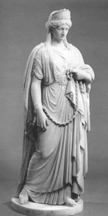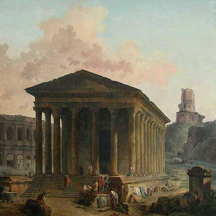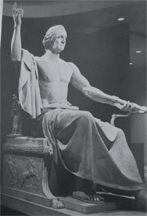LESSON TWO /
TRAVELERS IN EUROPE
American travelers to Europe sought first-hand experience with Roman and Greek antiquities, with profound effects on ideas and style. |
Guiding Ideas and Themes
- As a minister of the American government to France, Thomas Jefferson traveled in France from 1784 to 1789 with profound effects on subsequent American government, ideas and design.
- 19th-century statesmen, literary giants, and artists visited Rome to reflect on and imitate classical models.
- Americans who did not travel to Europe became learned in the classics and antiquity through books, engravings and paintings.
Thomas Jefferson and Antiquity
Thomas Jefferson’s travels were of importance not only for the antiquities he encountered. Jefferson was also conducting a modern sociological study of French and Italian manners and of continental economic innovations.
He never traveled to Florence or Rome; his Italian travels were limited to Genoa and Turin. Jefferson first became familiar with classical architecture and the Pantheon through Andrea Palladio, a sixteenth-century Venetian architect and classicist influenced by Vitruvius and Roman classical building, the styles of the first century B.C. to the second century A.D. The Pantheon was the prototype for Jefferson’s Rotunda at the University of Virginia.
- What was the Maison Carrée?
Jefferson was equally influenced by the French architect and painter Charles-Louis Clérisseau, who published Antiquités de la France, Prèmiere partie: Monuments de Nismes in 1778. The Pantheon and Maison Carrée (first from Clérisseau) had profound impact on Jefferson’s architecture. On his travels in southern France in 1787, several years after the classical temple at Nîmes had become known to him through Clérisseau’s book, Jefferson was able to see Maison Carrée with his own eyes. He wrote to his friend Madame de Tesse, from Nîmes on March 20:
Here I am, Madam, gazing whole hours at the Maison quarree, like a lover at his mistress. … From Lyons to Nismes I have been nourished with the remains of Roman grandeur. … The Praetorian palace, as it is called, comparable, for its fine proportions, to the Maison quarree, defaced by the barbarians who have converted it to its present purpose, its beautiful fluted Corinthian columns cut out, in part, to make space for Gothic windows, and hewed down, in the residue, to the plane of the building, was enough, you must admit, to disturb my composure. At Orange too, I thought of you. I was sure you had seen with pleasure, the sublime triumphal arch of Marius at the entrance of the city. I went then to the Arenae. Would you believe, Madam, that in this eighteenth century, in France, under the reign of Louis XVI. they are at this moment pulling down the circular wall of this superb remain, to pave a road?
Architect Thomas Jefferson later said at the dedication of his Virginia state capitol at Richmond:
We took for our model what is called the Maison Quarree of Nismes, one of the most beautiful, if not the most beautiful and precious morsel of architecture left us by antiquity. It was built by Caius and Lucius Caesar, and repaired by Louis XV, and has the suffrage of all the judges of architecture who have seen it as yielding to no one of the beautiful monuments of Greece, Rome, Palmyra and Balbec, which late travelers have communicated to us. It is very noble beyond expression, and would have done honor to any country, as presenting to travelers a specimen of taste in our infancy, promising much for our maturer age.
- What was Jefferson’s symbolic purpose in using the Maison Carrée as a prototype? What expressions in Jefferson’s letter indicate his enthusiasm for classical architecture?
- Take a look at Jefferson's Virginia Capitol: from an exhibition at the University of Virginia.
- What aspects of the Maison Carrée most interested Thomas Jefferson, according to his letter to Mme. De Tesse?
- For further study of the Neoclassical temple, both in its design and influence, this online resource from the Metropolitan Museum of Art provides plentiful links:
All about the Neoclassical temple
Nicholas Biddle and the Greek Revival
Consider the contributions of Nicholas Biddle and his influence on Neoclassicism.
In the first third of the 19th century Nicholas Biddle (1786-1844) was the most powerful banker in the U.S. with immense influence among the new nation’s political and cultural elites. Biddle began to build his private home in Philadelphia, called Andalusia, in the Greek style in 1794. Then, Biddle traveled in Greece in 1806, when it was still under Ottoman rule, and returned to the U.S. as an enthusiast of the classical age and design.
- Biddle was one of the few people of his generation who actually saw real ancient Greek buildings, or the remains of them, on their home ground. He was a patron of Greek Revival architecture.
- After Greece became independent of the Ottoman Empire, 1821-1832, a general wave of philhellenism swept Europe and America.
- Biddle promoted a Greek architectural revival in the U.S. He added a Greek façade to his house in 1835-1836. All the branch offices of the Bank of the United States were built in the style he approved, and only in the twentieth century did banks cease to look like Greek temples.
Biddle’s contributions as a banker and neoclassicist are examined in an original article by Jeffrey Sklansky, “A Bank on Parnassus: Nicholas Biddle and the beauty of banking”:
Nicholas Biddle's dreams and achievements: an assessment
- For more on Biddle’s Greek travels, see Richard A. McNeal, ed., Biddle in Greece: The Journals and Letters of 1806 (Pennsylvania State, 1993):
Nicholas Biddle's journal in Greece
American Neoclassical Artists
Benjamin West (1738-1820) was the first internationally known American artist. Born in Philadelphia, he traveled to Italy in 1760. He was twenty-one years old at the time. West lived there for three years. He then settled in London, where his history paintings were greatly admired with lasting impact on English art. He ascended to the apex of British art circles and famously assisted American artists visiting London. West helped found the Royal Academy of Art and the future National Gallery of London. He became President of the Royal Academy and royal painter to King George III. West was an important influence on subsequent American painting because two generations of American students including Washington Allston, John Vanderlyn, and Gilbert Stuart passed through his London studio.
Explore West’s influence on his many American students, using this web resource from the Metropolitan Museum of Art:
Why is West a pivotal figure in American culture and the development of Neoclassicism? How does West’s life illustrate the close cultural links between North America and London during his long lifetime?
What began with Benjamin West did not end with West. During the 19th century a growing number of American scholars, literary figures, and artists lived in England and Europe. A large number of American Neoclassical sculptors lived and worked in Italy.
In America's Rome (Yale, 1989) William L. Vance paid particular attention to the lives of Horatio Greenough (1805-1852), Hiram Powers (1805-1873), and Harriet Hosmer (1830-1908). The Art Institute of Chicago designates these three the leading American Neoclassical sculptors of the 19th century. All of these Neoclassical sculptors worked in Italy for long periods of time. (In addition, Vance examines the Apollo Belvedere, Medici Venus, Laocoon, the Dying Gladiator, and other classical works as prototypes for all American Neoclassical sculpture and aspiring academic artists.)
American Neoclassical sculptors in Europe
Horatio Greenough went to Italy for two years, starting in 1825, continuing his art studies with visits to museums and lessons at the French Academy. His George Washington (1832), his best-known work, was not a critical success. Investigate what art historians have said about it. In what ways did Greenough over-classicize the American hero?
Greenough’s Neoclassicism presents Washington as a mythic Roman statesman or god, half-naked and draped with a toga, holding a sword. |
Hiram Powers’ The Greek Slave was a famous signifier of the American anti-slavery abolitionists.
In 1843, Hiram Powers, living in Florence, produced his celebrated statue, The Greek Slave, which at once gave him a place among the leading sculptors of his time. It was exhibited at London’s Crystal Palace Exhibition and Elizabeth Barrett Browning wrote a sonnet on it. Modeled after the Medici Venus in the Uffizi, The Greek Slave was widely reproduced and imitated, achieving great visibility and renown before the Civil War as a symbol of abolitionism. Copies of The Greek Slave appeared in many Union-supporting state houses. In fact Powers meant it to be a celebration of Christianity’s victory over Ottoman slavery and of the liberation of Greece from Turkish rule. But the virtuous and chaste nude in chains was too powerful an image for abolitionists and anti-slavery Americans not to venerate.
For more about The Greek Slave
Powers’ iconic slave served as a reminder of the Greek wars against heathen Turkey and the evils of black slavery in the U.S. |
Explore Harriet Hosmer’s life as an expatriate and the development of her feminist themes in allegorical marble works.
In 1852, at the age of 22, Harriet Hosmer moved to Rome where she worked in the Neoclassical style for most of her life. Hosmer’s most famous work was of Zenobia, the third-century Syrian queen known for her courage, intelligence and beauty. When shown in New York City and Boston in 1864, her work drew crowds and acclaim, and accolades from William Cullen Bryant, Frederick Church and Albert Bierstadt. Nathaniel Hawthorne, visiting Hosmer’s studio in 1858, called it “very noble and remarkable.” In Hosmer’s work, the fallen queen stands defeated but with great dignity. Hosmer's work, according to the Art Institute of Chicago, “addresses the theme of strong women whose power was thwarted by the injustices of society.”
Why was Zenobia a compelling historical figure for Harriet Hosmer?
 |
Zenobia conquered much of Asia Minor and Egypt, claiming parts of the Roman Empire. When in 272 the Romans under Aurelian sacked Palmyra, Zenobia was captured and paraded in Rome as a captive. |
For Further Study
- Joseph Addison’s 1713 drama, Cato, was extremely popular and well known to American revolutionary leaders. George Washington famously had it performed for his soldiers at Valley Forge. Why was the play so popular and influential for revolutionary Americans?
Addison's Cato and its significance for Americans
Cato the Younger’s remarkable story and fight for the republic against the rise rise of Caesar is told in a fine, readable biography: Rome's Last Citizen: The Life and Legacy of Cato, Mortal Enemy of Caesar by Rob Goodman (St. Martin’s, 2012).
- Read an extract of Nathaniel Hawthorne’s The Marble Faun (1860) in which Hawthorne describes classical statuary. This novel of intrigue contains many wonderful descriptions of ancient Rome set against the drama of the characters in 19th-century Rome. Hawthorne mentions many works of ancient art when he describes a trip to the Capitoline Museum. What are some of them? Identify an antique work -- the Faun of Praxiteles is only one obvious choice -- that Hawthorne singles out in the book. Why does Hawthorne find various works outstanding or worthy of notice?
Nathaniel Hawthorne's The Marble Faun
- Explore the life, works and significance of one of America’s last great neoclassicist artists, Augustus Saint-Gaudens, who began his career in the 1870s in Rome. Saint-Gaudens was an academic classicist who became the most influential sculptor in the United States during the last quarter of the 19th century.
More about St.-Gaudens from the Metropolitan Museum of Art
![]()




